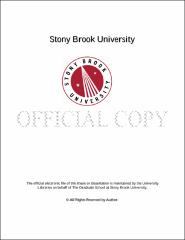| dc.identifier.uri | http://hdl.handle.net/11401/77580 | |
| dc.description.sponsorship | This work is sponsored by the Stony Brook University Graduate School in compliance with the requirements for completion of degree. | en_US |
| dc.format | Monograph | |
| dc.format.medium | Electronic Resource | en_US |
| dc.language.iso | en_US | |
| dc.publisher | The Graduate School, Stony Brook University: Stony Brook, NY. | |
| dc.type | Thesis | |
| dcterms.abstract | While Jane Austen’s novels were published over two hundred years ago, her stories continue to captivate audiences through print and the screen. There seems to be a growing tradition of adapting certain novels, such as Pride and Prejudice, over other ones like, Northanger Abbey, Persuasion, and Mansfield Park. In this paper I explore how the former three novels differ from Pride and Prejudice from their heroines and heroes to the romantic relationships between the two protagonists. Then I take into consideration the large impact of Colin Firth’s Mr. Darcy in influencing Austen’s other heroes such as Captain Wentworth, Henry Tilney and Edward Bertram, by giving them more emotions and love speeches. All of these elements help prove why these three novels are often adapted less frequently than the forever popular Pride and Prejudice. | |
| dcterms.abstract | While Jane Austen’s novels were published over two hundred years ago, her stories continue to captivate audiences through print and the screen. There seems to be a growing tradition of adapting certain novels, such as Pride and Prejudice, over other ones like, Northanger Abbey, Persuasion, and Mansfield Park. In this paper I explore how the former three novels differ from Pride and Prejudice from their heroines and heroes to the romantic relationships between the two protagonists. Then I take into consideration the large impact of Colin Firth’s Mr. Darcy in influencing Austen’s other heroes such as Captain Wentworth, Henry Tilney and Edward Bertram, by giving them more emotions and love speeches. All of these elements help prove why these three novels are often adapted less frequently than the forever popular Pride and Prejudice. | |
| dcterms.available | 2017-09-20T16:52:56Z | |
| dcterms.contributor | Martinez-Pizarro, Joaquin | en_US |
| dcterms.contributor | Munich, Adrienne | en_US |
| dcterms.creator | Reese, Stephanie Ann | |
| dcterms.dateAccepted | 2017-09-20T16:52:56Z | |
| dcterms.dateSubmitted | 2017-09-20T16:52:56Z | |
| dcterms.description | Department of English. | en_US |
| dcterms.extent | 49 pg. | en_US |
| dcterms.format | Application/PDF | en_US |
| dcterms.format | Monograph | |
| dcterms.identifier | http://hdl.handle.net/11401/77580 | |
| dcterms.issued | 2016-12-01 | |
| dcterms.language | en_US | |
| dcterms.provenance | Made available in DSpace on 2017-09-20T16:52:56Z (GMT). No. of bitstreams: 1
Reese_grad.sunysb_0771M_12650.pdf: 717595 bytes, checksum: 2ea95f66814101b342bd0e5fd17ed85c (MD5)
Previous issue date: 1 | en |
| dcterms.publisher | The Graduate School, Stony Brook University: Stony Brook, NY. | |
| dcterms.subject | English literature | |
| dcterms.title | Jane Austen from Page to Screen: How Current Society and " Pride and Prejudice" have Shaped " Northanger Abbey," " Persuasion," and " Mansfield Park" on Film | |
| dcterms.type | Thesis | |

